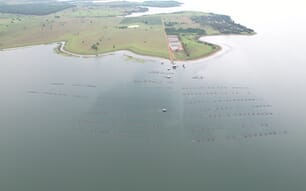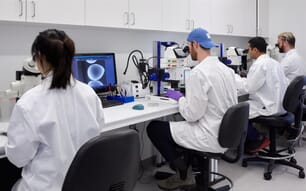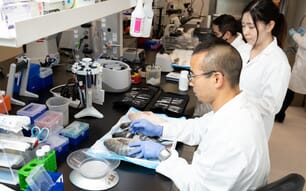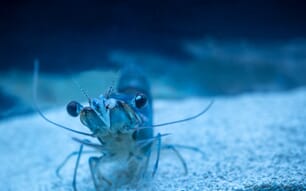
Aquaculture is famous for the huge diversity of species involved in the sector: according to FAO, over 600 are currently being produced. While the industry is dominated by a handful, both in terms of volumes and values, there are strong arguments for ensuring that production remains so diverse.
The Center for Aquaculture Technologies (CAT) is an advocate for this diversity and is currently working with nearly 30 species and would embrace investigating more, as Alejandro Gutierrez, CAT’s director of genetic services at and his colleague Marcos De Donato, a breeding scientist, explain.
“It is important to diversify aquaculture production to meet the increasing demand for fish protein in various markets and to avoid reliance on particular species or strains. This increased diversity will secure resilience of the global food system against climate change, diseases, and market pressure,” Gutierrez reflects.
"The strength of CAT is that we can come up with genetic tools for basically any species. These can be used for breeding programmes, commercial production, but also for research to assess the health of natural populations and whether they are under genetic stress from things like overfishing. These tools are useful for any type of genetic study,” notes De Donato.
“With a relatively small budget we can come up with tools for any species that we can get hold of their DNA – so far we have 28 species, ranging from fish to crustaceans, to molluscs and insects [for aquafeeds],” he adds.
According to Gutierrez, at least 80 percent of the aquaculture sector is growing animals that have gone through some form of selection process. And the figure might even be higher, due to the huge production volumes in China, where genetic selection tools are being vigorously promoted, but where reliable data are harder to aggregate.
However, they note that there are actually a number of advantages of working with species that are less domesticated – especially if compared to working with one that has been badly bred, and suffers from inbreeding.
“If it’s a new species then customers will have started with wild-caught broodstock, which is good because wild populations generally have a lot of genetic variability, which is the key ingredient for successful genetic programmes. If you start with a small genetic base, then you are starting handicapped,” De Donato explains.
However, on the flip side, the lack of domestication tends to lead to huge disparities in factors such as growth rates and colouration.
“In every batch you tend to have a large proportion of individuals from a small number of dominant broodstock – it’s a risk, because very soon you’ll have inbreeding depression,” he adds.

The lab is used to create SNP panels and process samples. © CAT
First steps
The team at CAT are always keen to be involved from as early in the process as possible – as long as the farmer has closed the lifecycle of the species, so they can select the animals that produce the next generation.
“What we’d usually recommend to any client is that we first carry out a genetic overview of their stock so that we have an idea of how closely related they are and how much potential they have for selection in the coming generations,” explains Gutierrez,
“After that, we will be able to identify the parentage of the population and how many are contributing to the reproduction,” he adds.
Typically, if a molecular tool is not available, this will involve developing a panel of markers to allow CAT to genotype some of the individuals within the breeding population – this is all the more important in emerging species as many will not have been genomically sequenced, meaning that the key building blocks are not yet in place.
“This is one of the most popular services that we have, as there’s no one else doing as many panels as we do and we have all the tools to create panels very quickly – in around three months we can have one up and running,” explains Gutierrez.
All CAT requires are tissue samples from a customer’s broodstock, which allows them to identify markers and each LD panel usually contains 300-400 of these markers.
“We prioritise markers that will be informative throughout multiple populations, being capable to determine genetic variation and perform parental assignment but we usually also include markers associated with sex, with disease-resistance, growth – we’re open to include as many as possible – but we only add the most useful ones to the panels,” notes Gutierrez.
CAT typically decides which markers to include, but with input from the client and genotypes as many animals as the customer wants to create a panel – usually in the range of 100 individuals.

Who should consider genetic services?
As far as the team at CAT is concerned, developing panels and using genotype data is worthwhile for any breeding programme, regardless of the size of the business.
“The tools are so important, as you can predict the future of the population based on the level of inbreeding and the level of variability,” notes De Donato.
And it helps that these services are becoming increasingly affordable, aided by the technology and experience that genetics service companies have amassed.
“Ten years ago it would have been very expensive to develop the tools but – given our resources and expertise – it’s now very affordable compared to the benefits it can bring you,” he adds.
As a result, CAT is seeing an increasingly diverse range of customers – ranging from producers of key seafood species like tilapia, to companies that sell fish for recreational anglers, to ornamental fish breeders.
Key traits for emerging species
Much like in the farming of conventional species, growth, reproductive traits and disease-resistance levels tend to be most in demand for selection. However, as many emerging species are only a generation or two from wild fish, it can also be important to select for traits that can fast-track the domestication process, not least as a way of reducing stress levels in the species.
“If you can select for resistance to stress it will have an impact on rates of survival, especially when the fish are in their larger stages and worth a lot of money,” notes De Donato.
“We can target resistance to specific diseases, either by exposing them to diseases in a controlled environment or just exposing them in a natural environment,” he adds.
In most scenarios, the priorities of the customers will change, as the genetic services start to impact key traits, and so customers can refine their genetic characteristics.
How can producers measure success?
Measuring the impact of using genetic services is essential to ensuring that they are worthwhile.
“Good data are essential to measure the success of any breeding project, and we are happy to help customers collate this information so that a programme’s impact can be accurately assessed,” observes Gutierrez.
Tagging fish with devices like PIT tags, which allow individual animals to be closely tracked and measured is extremely useful as programmes become more sophisticated – something that CAT emphasises to all its customers.
“You rely on the quality of the phenotypic data, to allow you to make a connection between the genetic characteristics and the phenotypic characteristics, so you can analyse the genetic potential,” De Donato points out.
Meanwhile the speed of improvement largely depends on the generation length of that particular species. However – in general – improvements tend to be more dramatic the more recently the species has been domesticated.
“You can see results after the first generation [of our involvement] – especially in terms of the increase in homogeneity. That’s the first sign that the selection process is working, then you start tracking gains – you see that they grow faster and have better survival,” says De Donato.
“In more domesticated species, you will probably see a slower response, but after two or three generations you start seeing clear differences from before and after the breeding programme,” he adds.
Choosing the best option
These patterns are mirrored by the economic gains – with breeding programmes for emerging species typically paying dividends for breeders more quickly. However, this will depend on the techniques being used and CAT currently has three different options.
“A mass selection programme will have a slower outcome, because it’s based on phenotypic observations. If you have a pedigree breeding programme the improvement will be much faster, while if we go into genomic selection – which is more complex and based on genetic information – then the improvement will be even faster,” Gutierrez explains.
“When you’re working with an emerging species you don’t typically go with the most complex breeding programmes. We usually try to keep things running the way they were until we have a clear picture of what the population looks like in term of variability, or what the customer can do with the space and infrastructure they have. Once they are ready to move on to family or pedigree selection we will start to do genotyping and establishing the best families to reproduce from. Once that’s set up we could potentially move to genomic selection, which is much more complex and we use genetic information to select the best fish,” he adds.
CAT likes to continue to work with breeders, and tends to gradually step up the sophistication of the tools that they use, as the breeding programme evolves.
According to Gutierrez, long partnerships will continue to pay dividends, even if an emerging species becomes more mainstream.
“There’s no limits to improvement for any species. Everyone thought we’d reach a plateau but we’re still seeing huge improvements in chickens and cattle, for example. So we need to continue to help customers to select the best animals,” he emphasises.

© CAT
While such improvements can continue by using the same techniques, the process can also be sped up by bringing more complex tools into play.
“We’re now able to harvest very sophisticated information from the panels. When we start we use low density panels that contain around 400 markers, but by the time we go into genomic selection we use high density panels that contain thousands of markers. Those will give us a very in-depth picture of the relationship between the animals – we can identify animals that are best suited for the next generation,” Gutierrez explains.
And, looking ahead, there is one technique that will almost certainly have a huge impact on breeding programmes – gene editing – as it will allow much faster improvements to take place.
“While a breeding programme might take five or six generations to reach a certain level of selection for a specific gene, gene editing can do it in a single generation, because all the animals will have the edited gene,” explains Gutierrez.
“It’s the way things are moving, even in human medicine too, you can edit specific genes within the genome of the animal. It’s completely different from GMO, as we don’t introduce anything different from the animal or any other species, we just edit a particular gene that we know has an effect on growth, for example, or disease-resistance and this edit will be shown in the offspring of these animals in the future – you can develop a highly disease-resistant population in a very short time,” he adds.






